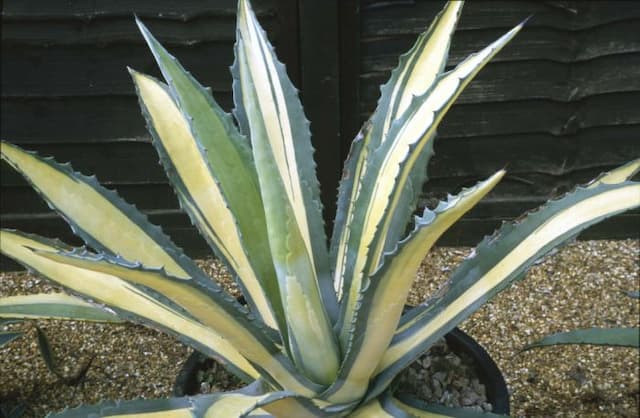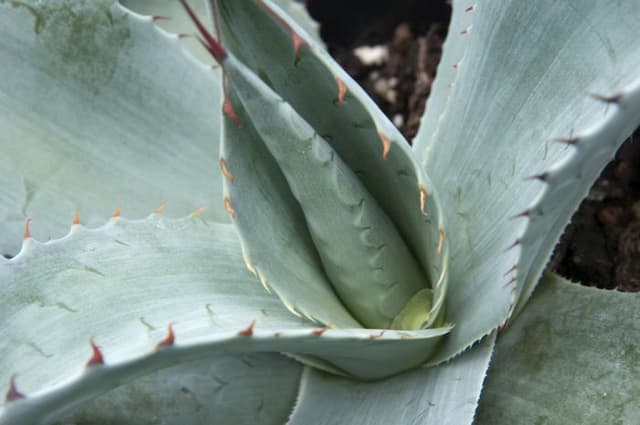Hyacinth Hyacinthus orientalis 'Aida'

ABOUT
The Hyacinth 'Aida' is an ornamental plant known for its showy, fragrant flowers that appear in early spring. Its blooms grow in dense, star-shaped clusters at the top of sturdy, upright stalks and come in a deep violet-blue hue. Hyacinth 'Aida' has a strong sweet and lingering scent that makes it popular for gardens and as a cut flower for indoor enjoyment. The leaves of the Hyacinth 'Aida' are bright green, glossy, and sword-shaped, forming a striking contrast with the richly colored blooms. These leaves grow from the base of the plant, creating a lush frame for the upright bloom spikes. Each individual flower on the spike is bell-shaped with recurved petals, contributing to the overall plush appearance of the flower cluster. As a bulbous plant, Hyacinth 'Aida' begins its growth cycle from an underground bulb which contains all the necessary nutrients to support the initial growth of the plant. After flowering, the plant goes into dormancy, with the bulb storing energy for the next growing season. This cycle of growth and dormancy makes the Hyacinth 'Aida' an easy-to-care-for addition to a variety of garden settings.
About this plant
 Names
NamesFamily
Asparagaceae
Synonyms
Common Hyacinth, Garden Hyacinth, Dutch Hyacinth
Common names
Hyacinthus orientalis 'Aida'.
 Toxicity
ToxicityTo humans
The common name of Hyacinthus orientalis 'Aida' is hyacinth. Hyacinths contain chemical compounds that can be toxic when ingested, leading to symptoms of poisoning such as nausea, vomiting, diarrhea, and in severe cases, can cause depression of the central nervous system. Touching the plant can also cause skin irritation due to the oxalic acid and other compounds in the bulb. It is advised to handle the plant with care and prevent children from ingesting any part of the plant.
To pets
Hyacinths are toxic to pets, such as cats and dogs. Ingesting any part of the hyacinth can lead to symptoms such as vomiting, diarrhea, drooling, and can also cause depression. Depending on the amount ingested, more severe symptoms could occur, including heart rate changes and breathing difficulties, which can potentially be life-threatening. Immediate veterinary attention is recommended if a pet ingests this plant.
 Characteristics
CharacteristicsLife cycle
Perennials
Foliage type
Deciduous
Color of leaves
Green
Flower color
Purple
Height
8-12 inches (20-30 cm)
Spread
4-6 inches (10-15 cm)
Plant type
Bulb
Hardiness zones
4
Native area
Mediterranean
Benefits
 General Benefits
General Benefits- Ornamental Value: Hyacinth 'Aida' is known for its showy, fragrant flowers that add beauty to gardens and landscapes.
- Aesthetic Improvement: The vibrant colors of the hyacinth can enhance the aesthetic appeal of any setting, including flower beds, borders, and containers.
- Sensory Experience: The sweet and strong fragrance of Hyacinth 'Aida' provides a delightful olfactory experience in the spring garden.
- Spring Bloom: Hyacinths are among the first flowers to bloom in spring, bringing an early splash of color after the winter months.
- Cut Flowers: Hyacinth 'Aida' is suitable for creating fragrant and attractive floral arrangements as cut flowers.
- Pollinator Attraction: While Hyacinth 'Aida' is not the top plant for pollinators, it still can attract bees to the garden early in the season.
- Ease of Care: Hyacinths, including 'Aida', are relatively easy to grow with minimal maintenance required.
- Seasonal Celebrations: Hyacinths are often used for festive decorations around Easter and spring celebrations.
- Bulb Forcing: Hyacinth bulbs, like 'Aida', can be forced to bloom indoors during the winter for a splash of color and scent.
- Symbolism and Gifting: Hyacinths are associated with rebirth and are often given as gifts in the springtime or used in seasonal decor.
 Medical Properties
Medical PropertiesThis plant is not used for medical purposes.
 Air-purifying Qualities
Air-purifying QualitiesThis plant is not specifically known for air purifying qualities.
 Other Uses
Other Uses- Hyacinth bulbs can be used as a natural adhesive due to the sticky substance they produce when cut or crushed.
- The heavy scent of hyacinths can be used to deter small rodents and pests from gardens when planted around the perimeter.
- Artists have utilized the intense pigments from the hyacinth flowers as a natural colorant for textiles and artworks.
- During the Victorian era, hyacinth flowers were used in potpourri mixes for their strong and pleasant fragrance, which was believed to uplift mood.
- In colder climates, hyacinth bulbs can be forced in winter to provide an early-spring-like atmosphere indoors when the landscape outside is barren.
- Hyacinth petals have been used historically in the creation of perfumes, offering a floral base noted for its intensity and longevity.
- The plant has been used in literature and poetry as a symbol of peace and tranquility, inspiring writers and poets.
- Due to their vibrant colors and structured shape, hyacinths are often incorporated into the design and planning of formal gardens and parks.
- Dried hyacinth flowers are sometimes used in the crafting of eco-friendly dyes for Easter eggs, providing a variety of hues.
- The flowering time of hyacinths can be a natural indicator letting gardeners know it is time to plant their summer-blooming bulbs.
Interesting Facts
 Feng Shui
Feng ShuiThe Hyacinth is not used in Feng Shui practice.
 Zodiac Sign Compitability
Zodiac Sign CompitabilityThe Hyacinth is not used in astrology practice.
 Plant Symbolism
Plant Symbolism- Rebirth: The hyacinth blooms in the spring, signaling the end of winter and the arrival of a new growth season, representing renewal and new beginnings.
- Consistency: Its regular blooming every spring makes the hyacinth a symbol of dependability and constancy.
- Playfulness: The dense, star-shaped flowers of the hyacinth add a playful touch to gardens, symbolizing fun and sport.
- Peace: The hyacinth is often associated with tranquility and peacefulness.
- Beauty: With its striking colors and pleasant fragrance, the hyacinth represents beauty and loveliness.
- Jealousy: In Greek mythology, the flower was associated with the sun god Apollo and a youth named Hyacinth. Their story involved envy, and thus hyacinth can symbolize jealousy.
- Power: Its intense fragrance and bold colors can represent power and might.
- Sorrow: Hyacinth sometimes conveys a sentiment of sorrow and a desire for forgiveness in the language of flowers.
- Pride: The stately appearance of the hyacinth may stand for pride or boastfulness.
 Water
WaterHyacinth ('Hyacinthus orientalis 'Aida') prefers to be watered moderately. During active growth in the spring, water the plant when the top inch of soil feels dry to the touch, which might mean watering once every week with about one gallon of water, depending on the environmental conditions. After the blooming period, reduce the frequency gradually as the leaves yellow and die back, signaling the beginning of the plant’s dormancy period. During dormancy in the summer and fall, watering should be minimal, only to prevent the soil from becoming completely dry.
 Light
LightHyacinths, including 'Hyacinthus orientalis 'Aida', require bright, indirect light when in bloom, but not direct sunlight as it may damage the flowers. The best spot for the plant would be in an east or west-facing window where it can receive gentle morning or late afternoon sun.
 Temperature
TemperatureHyacinths, such as 'Hyacinthus orientalis 'Aida', thrive in cooler temperatures and should be kept in an environment between 60 and 70 degrees Fahrenheit during their growing season. They can withstand brief periods outside of this range but should not be exposed to temperatures below 25 degrees Fahrenheit or above 75 degrees Fahrenheit as extreme temperatures can damage the plant.
 Pruning
PruningHyacinths ('Hyacinthus orientalis 'Aida') do not require extensive pruning but deadheading, the removal of spent flower stalks, will prevent the plant from expending energy on seed production. Prune back the flower stalks after blooms have faded, usually in late spring, but leave the foliage intact until it has fully yellowed and died back naturally to allow the plant to store energy for the next year's growth.
 Cleaning
CleaningAs needed
 Soil
SoilHyacinth prefers a soil mix that is well-draining, fertile, and rich in organic matter, with a pH of 6.5-7.0. A mixture of two parts loam, one part river sand, and one part compost or well-rotted manure creates an ideal environment. Avoid heavy clay or overly sandy soils to ensure proper growth.
 Repotting
RepottingHyacinths, including 'Aida', do not need frequent repotting and are typically repotted every 2 to 3 years. However, they should be replanted annually if grown in containers, where bulbs are lifted after the foliage has died back and then stored cool and dry until the next planting season begins.
 Humidity & Misting
Humidity & MistingCommon hyacinths, like 'Aida', thrive best in average home humidity levels, ideally around 40-60%. They are not particularly humidity-sensitive but benefit from a moderate environment, as overly dry air can impede their growth.
 Suitable locations
Suitable locationsIndoor
Place 'Aida' Hyacinth in bright, indirect light indoors.
Outdoor
Plant 'Aida' Hyacinth in well-drained soil, full sun.
Hardiness zone
4-8 USDA
 Life cycle
Life cycleHyacinth 'Aida' begins its life cycle as a bulb, which remains dormant until the conditions are favorable, typically in autumn or early winter. It then starts to develop roots and shoots, emerging from the soil in late winter to early spring as foliage and a flower stalk. The plant blooms in spring, showcasing fragrant flowers in dense spikes. After flowering, the foliage remains to photosynthesize and replenish the bulb's energy reserves. By late spring or early summer, the leaves yellow and wither as the plant enters dormancy. The bulb then lies dormant through the summer and the cycle is ready to begin anew when the weather cools.
 Propogation
PropogationPropogation time
Spring
The most popular method of propagating Hyacinthus orientalis 'Aida', commonly known as the hyacinth, is through bulb division. This is ideally done in late summer or early fall after the leaves have died back. You carefully dig up the bulbs, gently separate the smaller offset bulbs, which are known as bulblets, from the base of the mother bulb. These bulblets should have some roots attached. You then plant them immediately at the same depth they were growing before, which is typically around 4 to 6 inches deep (10 to 15 centimeters) and about the same distance apart. Water them well to settle the soil, and wait for the new growth in spring. This vegetative approach ensures that the new plants will be true clones of the parent, exhibiting the same color and growth characteristics.



![Beschorneria [Flamingo Glow]](/_next/image?url=https%3A%2F%2Fplants-admin.emdemapps.com%2Fimages%2Fplants%2F%2Fimages%2F604b59df2e78d.png&w=640&q=75)




